Concepts described as “spectral warfare” and “spectral dominance,” and related technologies, are emerging as key factors in work related to the U.S. Air Force’s multi-faceted Next-Generation Air Dominance program, or NGAD.
Budget documents point to a central goal for the service to be able to ‘dominate’ in a future aerial warfare battlespace defined on all sides by things like infrared search and track systems and missiles with multi-mode seekers, as well as advanced radars and electronic warfare systems. This is already having impacts on the design of a future sixth-generation stealthy crewed combat jet and that of advanced drones called Collaborative Combat Aircraft all being developed under NGAD.
Details about the Air Force’s spectral warfare and spectral dominance plans are spread across various items in its latest budget request for the 2024 Fiscal Year, as well as those from previous years. These efforts are also linked to an initiative within NGAD to take various steps to ensure that the service can reliably achieve air superiority, even against high-end potential adversaries like China or Russia, in the next decade.
NGAD is a broad effort that includes work on new weapons, sensors, networking and battle management suites, advanced jet engines, as well as the sixth-generation combat jet and advanced drones, as you can read more about here.
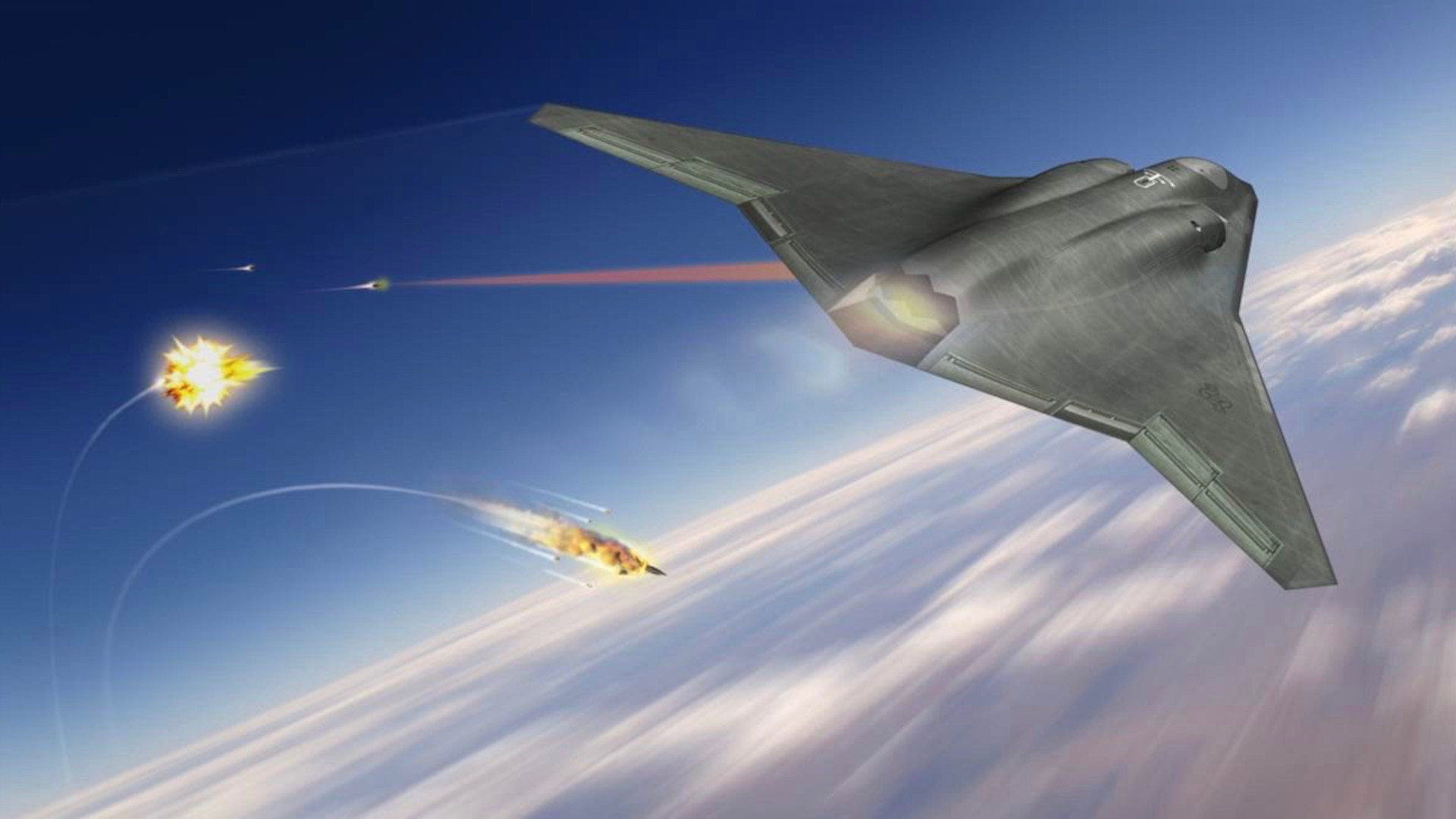
As part of NGAD, “the 2030+ Air Dominance (AD) candidate concepts consist of operational analyses, threat studies and technology candidate assessments and prototyping to identify operational concepts and technologies that improve persistence, survivability, lethality, connectivity, interoperability, and affordability in 2030 and beyond,” one section of the Air Force’s Fiscal Year 2024 budget request says. “Furthermore, studies are required to develop operational/system architectures to include family [sic] of systems and spectral dominance platforms.”
A singular official definition of either spectral warfare or spectral dominance appears to be elusive at present. However, a relatively good understanding of what this entails can be found by looking at details of what look to be relevant projects contained within various sections of the 2024 Fiscal Year budget request, and others in recent years, broadly focused on advanced electronic warfare research and development tasks.
As some reports have already indicated, advanced radiofrequency electronic warfare capabilities are certainly among the components of all this. This includes advances in what is known as cognitive electronic warfare. As a general concept, this envisions various developments, enabled by artificial intelligence and machine learning technologies, to help accelerate and otherwise automate various electronic warfare functions, as you can read more about here. One hope is that this could eventually allow for the rapid development of new functionality for electronic warfare systems and the updating of those systems in near real-time via software patches, even on aircraft in flight on missions.
The Defense Advanced Research Projects Agency (DARPA) video below offers a very brief overview of cognitive electronic warfare and its potential benefits.

However, the Air Force’s “spectral warfare” and “spectral dominance” concepts look to be much more expansive than this. There is an especially heavy focus on new and improved infrared and laser-based sensors and seekers for weapons, as well as technologies to defeat enemies using similar capabilities.
For example, one line item, titled “Integrated EW Demonstration,” which the Air Force is seeking approximately $8.4 million in funding for in Fiscal Year 2024, talks specifically about interest in capabilities to “counter advanced complex electromagnetic threats in contested environments across radio frequency and electro-optic/infrared spectrums” and for use again “multi-spectral treats [sic; threats] in a complex electromagnetic environment.”
Another line item, labeled “Electro-Optical/Infrared Warfare Demonstrator,” speaks to a need for “next generation countermeasure techniques to address the complete range of multispectral (for example, dual band infrared) threats including advanced techniques versus advanced man portable air defense system and air-to-air threats with multimode capabilities.”
According to the Air Force’s proposed 2024 Fiscal Year budget document, the stated goals for this project in the 2023 Fiscal Year, which began on Oct. 1, 2022, include efforts to “complete assessment of developed low cost, integrated missile and laser warning capability to identify, geo-locate, and counter, using both laser and expendable countermeasure response techniques, advanced laser and electro-optical/infrared guided missile threats to aircrews.” Work to “develop multi-spectral electro-optical/radio frequency countermeasures and insert capabilities into existing and developing engagement modeling and simulation tools” is also on the stated agenda.
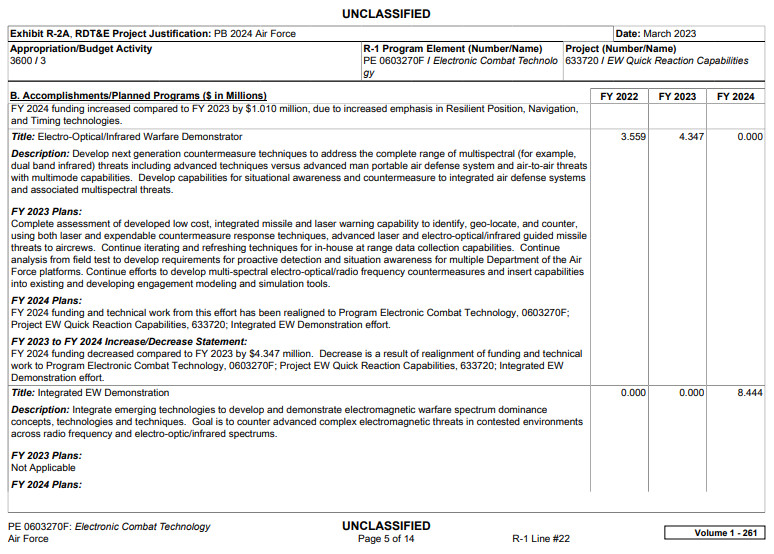
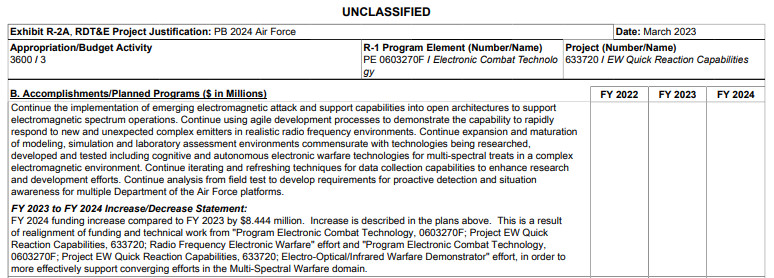
The Air Force is asking for no money for this particular item in the 2024 Fiscal Year due to plans to realign this work, and funding for it, under the Integrated EW Demonstration line item. The Electro-Optical/Infrared Warfare Demonstrator line item itself only came into existence in the 2022 Fiscal Year budget proposal due to a similar realignment.
As noted, 2030+ Air Dominance initiative, including its ‘spectral’ components, is part of NGAD and the Air Force budget documents underscore its links to the crewed and uncrewed aircraft development efforts within that larger program. “The 2030+ AD working groups methodically assessed candidate concepts using USAF directives and guidance that informed the NGAD Analysis of Alternatives (AoA) completed in 2019,” the main section on the initiative says.
The analysis of alternatives referred to here would seem likely to refer specifically to the stealth combat jet being developed under NGAD. That aircraft is known to be in development, though the current maturity of the design is unclear given how heavily classified the program has been. The Air Force has said that at least one demonstrator specifically related to this effort has flown and that other experimental aircraft initiatives fed into the project. It is known that F-22 Raptors are being used to support the NGAD development effort, as well.
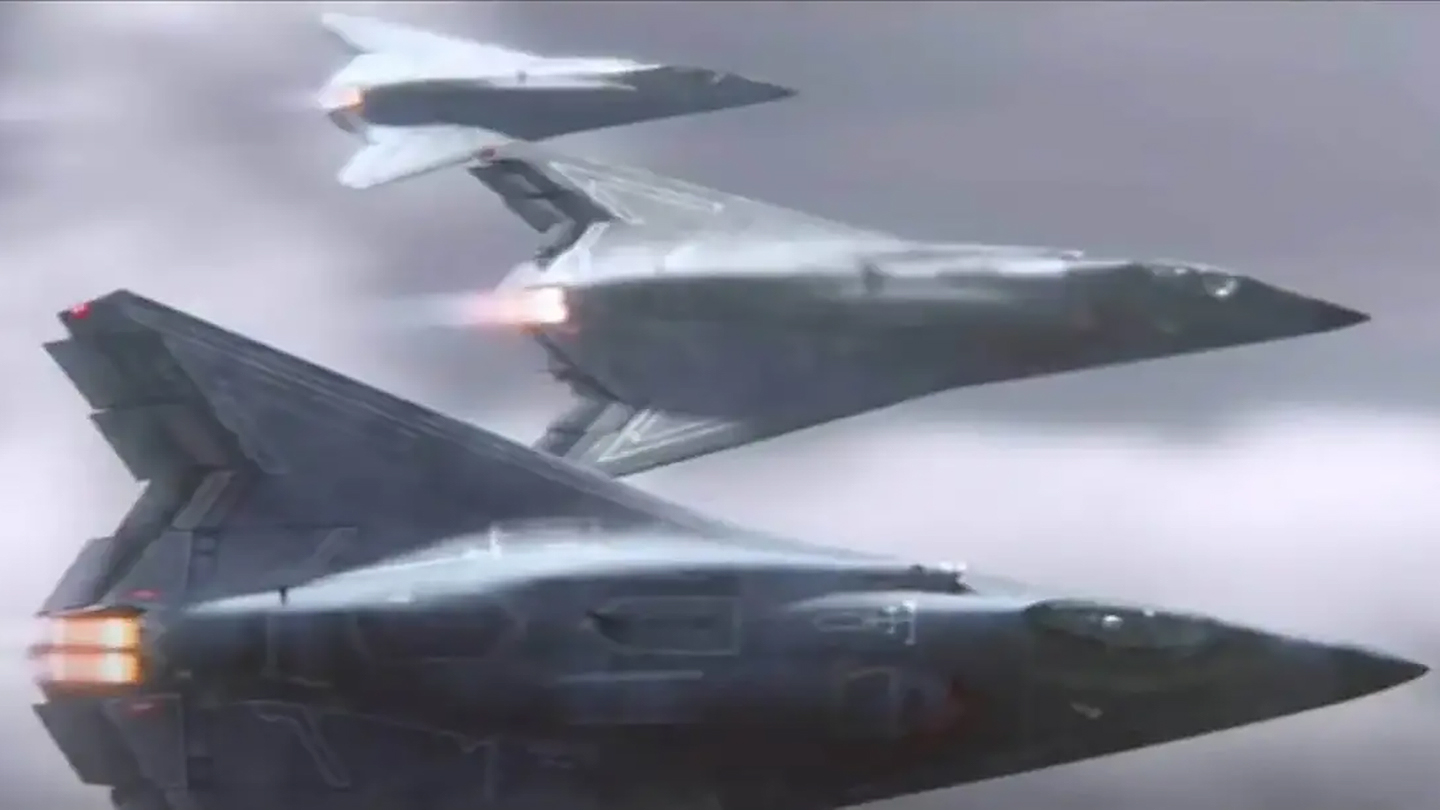
Furthermore, the line item for the Air Force’s future Collaborative Combat Aircraft (CCA) drones, for which the service is asking for some $392.2 million in funding in the upcoming fiscal year, says the work in the near term will include “ongoing studies… to refine CCA concepts as well as air superiority related technologies.”
It’s no secret that the Air Force views electronic warfare, and the ability to defend against enemy capabilities in this regard, are central to winning or losing future major conflicts. “If we lose the war on the electromagnetic spectrum, we’re going to lose the war and lose it quickly,” Air Force Gen. Mark Kelly, head of Air Combat Command (ACC), told The War Zone and others at a media roundtable earlier this month at this year’s Air & Space Forces Association Warfare Symposium.
China, in particular, is “increasing inventory levels and the sophistication of their weapons and modernizing redundant systems throughout the kill chains that support their weapons,” to include electronic warfare capabilities, Secretary of the Air Force Frank Kendall warned back in 2021. Russia has also made substantial investments into a diverse set of electronic warfare assets, several of which have been observed, as well as destroyed or captured, in the course of the fighting in Ukraine.
The Air Force has been far less pointed in its public statements about this broader ‘spectral’ focus. At the same time, longtime readers of The War Zone are unlikely to find any of this surprising.
For instance, the fact that the proliferation of stealth aircraft technology has led to a renaissance of sorts for infrared search and track (IRST) systems in the U.S. Air Force, as well as the U.S. Navy and Marine Corps, is something we report on regularly. There have been indications that IRST capabilities have been central to multiple U.S. Air Force advanced drone programs, including Skyborg and the secretive Off-Board Sensing Station (OBSS) program.

China and Russia have long had interests in IRSTs and have deployed increasingly capable types on many of their fighter aircraft. We are seeing other advanced sensor configurations emerge elsewhere, too.
IRSTs offer particular benefits for spotting and tracking stealthy aerial threats since their capabilities are not impacted by features intended to reduce a design’s radar cross-section. They are also immune to electronic warfare systems that disrupt radar and other radiofrequency emissions and operate passively, meaning a target will not be alerted to the fact they’ve been detected. This all makes IRSTs very valuable alternatives and companions to traditional radars, especially in battlespaces full of stealthy threats and heavy electronic warfare jamming, as you can read more about here.
Stealth has long been a U.S. advantage, but that advantage is bound to erode as stealth technology proliferates. As The War Zone has highlighted in the past, true ‘broadband’ stealth is also about more than just being able to decrease detection by various enemy radar systems and trying to reduce the signature of an aircraft’s exhaust. Being able to deny enemy detection via more comprehensive infrared, radio frequency countermeasures, and even visible spectrum is key.
As such, IRSTs are a major threat to the stealth aircraft advantage, but advanced integrated air defense systems, especially those that include IRST-like capabilities and high degrees of advanced computing and network connectivity, continue to increase in capability. That is a very worrisome reality.
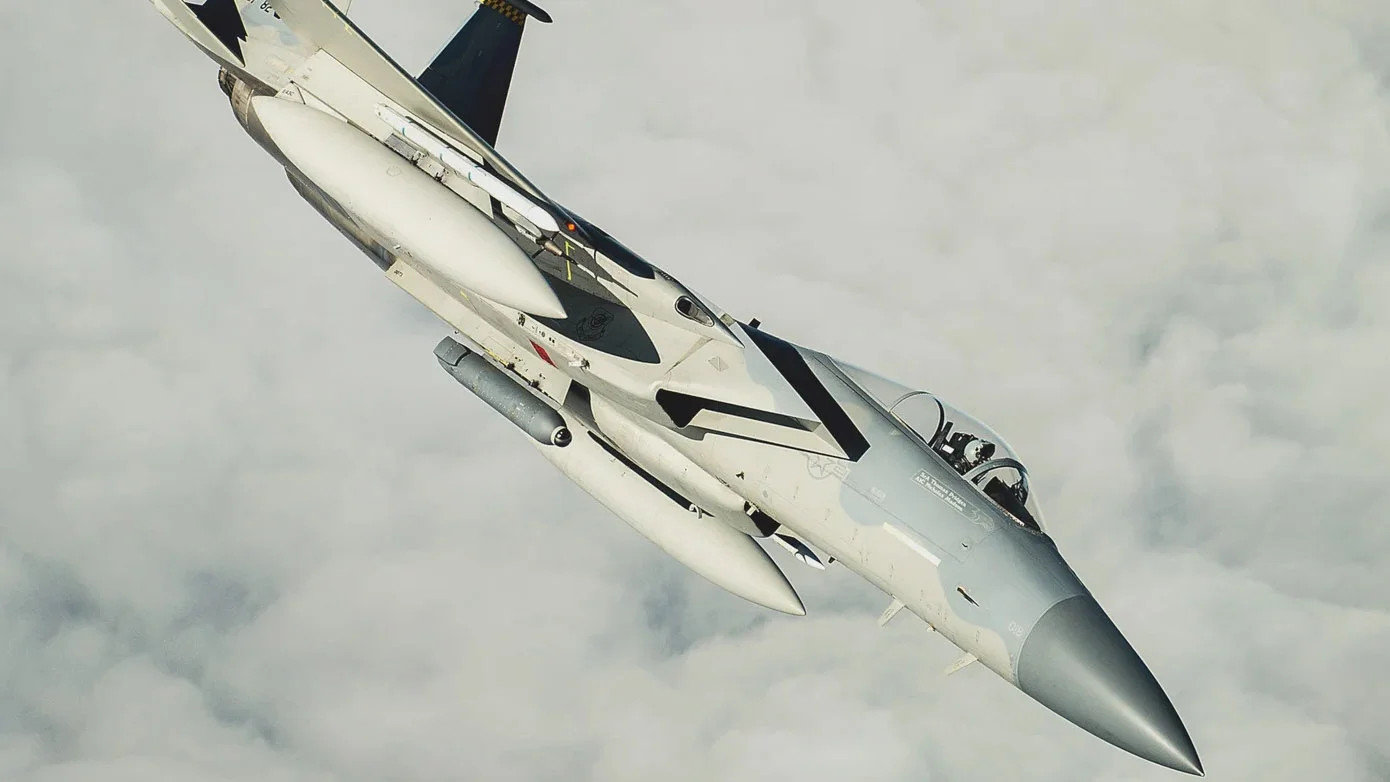
It is simply far harder to hide from multiple types of active and passive sensors working cooperatively over a broad area to detect, track, and subsequently engage an aerial platform. For instance, if just one sensor detects something, it can slew many other types of sensors in multiple locations onto that bit of sky, which, combined, could produce an actual track. The goal would be able to use this sensor-data fusion capability to the point that a weapons-engagement quality track could be achieved with the help of that multispectral data.
Similar factors are driving new interest in air-to-air and surface-to-air missiles with advanced imaging infrared seekers and especially ones that combine infrared, radar, and a data-link for offboard targeting information. Fusing all this information together, or at least having multiple forms of engaging a target, increases operational flexibility and resistance to countermeasures, and drastically increases a missile’s probability of kill.
If the Air Force’s Electro-Optical/Infrared Warfare Demonstrator effort seems oddly familiar, it should. The description of that project seems to fit in many ways with a number of unusual flight test activities that The War Zone has reported on in the past few years.
This includes multiple flight tests involving the Scaled Composites’ two mysterious Model 401 “Son of Ares” jets. In one instance a few years ago, one of the aircraft appeared to be covered in a mirror-like material.
U.S. Air Force F-22 Raptor and U.S. Navy F-35C stealth fighters, as well as still-flying F-117 Nighthawk stealth combat jets that are enjoying a very active ‘retirement,’ have also been observed in recent years with various types of metallic-looking coatings. The War Zone has posited in past that infrared signature reduction, or otherwise seeking to reduce the threat posed by IRSTs, could be one of the potential reasons behind the development of these mirror-like skins.

Separately, one of the Model 401s has been spotted on multiple occasions now with a ventral pod that increasingly appears linked in some way to work on a directed energy system. That this could be further linked to work on various kinds of lasers, including those used for weapon targeting and guidance, or as directed energy weapons for self-defense, or how to protect against them, has seemed like a distinct possibility. Directed energy weapons, and lasers especially, are known to be another central aspect of the larger NGAD effort.
Though it doesn’t appear to be explicitly mentioned in Air Force budget documents in the immediate context of other ‘spectral’ efforts, it seems highly probable that signature reduction in the visual spectrum is another part of all of this. Things like contrails and wingtip vapor vortices are also things that can give away the presence of an aircraft no matter how hard it may be to spot on radar. There have been decades worth of work in this arena already that could be leveraged and expanded upon, as you can read more about in this past War Zone feature.
Secretary Kendall, Chief of Staff Gen. Charles Q. Brown, and other top leaders within the service have been increasingly outspoken about the need to move quickly to acquire and field a host of new capabilities, as well as divest legacy assets to free up resources for those projects, to help maintain their edge in future high-end conflicts.
The Air Force itself is planning around a future force structure that will include 200 crewed NGAD combat jets, as well as an initial tranche of at least 1,000 CCA drones. Those figures are based on an initial concept of operation that would see each NGAD jet, as well as 300 F-35A Joint Strike Fighters, paired with two CCAs. Secretary Kendall has already said that the service could ultimately need twice as many CCAs, or more, and that they might not all be of the same time.

This being said, the Air Force does expect to weave capabilities being developed under NGAD into other existing fleets that it does plan to retain. The service says it will share those developments with other services like the Navy.
“We’re not going to do this [NGAD] in a serial fashion, where it’s all going to come out one big bundle like a Christmas present that you open, you know, on Christmas day,” Air Force Maj. Gen. R. Scott Jobe, director of Plans, Programs, and Requirements at ACC, said just today during an online webinar hosted by the Air & Space Forces Association’s Mitchell Institute. “This is gonna roll out and integrate with our existing fleet and forces that we have, both in the Air Force and on the Navy side of things, by the way. We have a lot of joint partnership[s] with the United States Navy right now as we’re moving this capability forward.”
The specific mention of collaboration with the Navy is interesting when looking at the ‘spectral’ aspect of the NGAD initiative given the appearance of mirror-like coatings on both Air Force and Navy jets.
“Whoever has that ability to gain air superiority with an air dominance type of family of systems is going to reap the rewards, both in operational [terms] and real cost in terms of lives [saved],” Maj. Gen. Jobe added during the Mitchell Institute talk.
As the Air Force pushes to advance its modernization priorities, and NGAD in particular, the exact scale and scope of the ‘spectral’ aspect of this effort may well become more and more clear.
Contact the author: joe@thedrive.com
